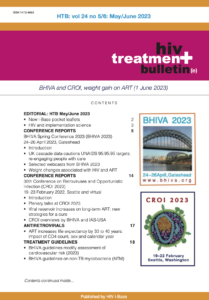Non technical HTB news: 12 stories from May/June issue
1 June 2023. Related: Editorial.
Simon Collins, HIV i-Base
 The notes below highlight 12 news stories in the May/June issue of HTB.
The notes below highlight 12 news stories in the May/June issue of HTB.
We say why these stories are important and exciting to know about.
Although HTB is written in more technical language for health workers, the news is also just as important for advocates.
1. HIV and implementation science
The editorial is about the average time (17 years) for a scientific discovery to be accepted and used in practice – and many advances never get used.
This should be much shorter for HIV care because of HIV implementation studies – and because of HIV conferences and community reports.
The editorial introduces other articles in the issue, including that it has taken from 4 to 18 years for some side effects to be clearly linked to different HIV drugs (see below)
CONFERENCE REPORTS: BHIVA and CROI
 We include three reports from the recent BHIVA conference.
We include three reports from the recent BHIVA conference.
2. UK 95:95:95 health targets
This article explains why the UK 95:95:95 targets might not represent what we think they mean. They are not percentages of all people living with HIV on ART, only those seen in care over the previous year.
Maybe 10 to 20% of people who might be lost to care are not included in these estimates.
3. Weight gain and HIV meds
The next article reports one of the main presentations looking at weight changes linked to HIV meds, especially integrase inhibitors and TAF. This issue is still not well understood, but switching from efavirenz and the original tenofovir which cause lower weight might be driving weight differences. Diet and being more active might both need to be used to lose weight now.
Finally, we include short summaries of eight webcasts from the conference. These are all now online – maybe pick one that you think sounds most interesting 🙂
 We also include three final reports from CROI 2023.
We also include three final reports from CROI 2023.
4. News about the viral reservoir
A review about the viral reservoir and cure-related research includes new discoveries over the last year showing that after many years on ART the viral reservoir actually starts to get bigger. Up until now researchers thought the reservoir steadily became smaller.
Most of these cells are just clone cells that don’t contain active HIV. This might mean that cure studies only need to activate a small proportion of reservoir cells, rather than all of them.
This was the first time I had heard about this and I thought it was exciting, even though it is technical.
Also, a short report about a potential test to predict who might be at risk of anal cancer.
Also links to CROI overviews by BHIVA and IAS-USA.
5. HIV and life expectancy
The latest study predicting life expectancy on modern ART includes that anyone starting at age 40 could expect to live another 30 to 40 years. The study talks about the differences between women and men. Also comparing those who started ART before and after 2015.
This is one of the first things we worry about when first diagnosed – so it is good to know about the latest research with modern meds.
6. PrEP news – F/TAF in the UK
NHS England approves use of F/TAF as alternative PrEP.
This means that people who are not able to use the original tenofovir (TD) can use TAF-based PrEP.
This is positive news that all advocates will want to know about 🙂
Complications and coinfections
7. Mpox vaccines
Two US studies report mpox vaccine efficacy might be lower than being reported in the UK. This might be only 36% vs 66% after a single- vs double-dose, respectively.
Please don’t forget that the UK deadline to get the second shot is 31 July. We included info in the previous HTB, together with reports of new mpox cases in London.
8. ART in the brain
This report is important because these results were not expected. It is different to current UK guidelines.
Even though it was a careful study, it was relatively small. This might be an example of where doctors chose not to act on the results. They might think it is still worth using small molecule drugs that do reach the brain.
What do you think?
9. First living liver donor – with HIV and HCV
This is a first case in the world of a living donor with HIV/HCV coinfection.
A mother in South Africa who is living with both HIV and hepatitis C was able to successfully be a living donor for her child. Both are now doing really well without complications.
The story includes a short video (of the operation).
10. Low CD4 without HIV?
We included the article in case you haven’t heard about this but also get contacted.
11. Covid-19 and tenofovir
12. Drug resistance and injectable CAB-LA
This study reports on the rates and risks of the A6 strain in Europe. It also discusses the implications for injectable CAB-LA for treatment or PrEP
Bonus: BHIVA guidelines
• Assessment of cardiovascular risk (2023)
• Non-TB mycobacteria (NTM)

